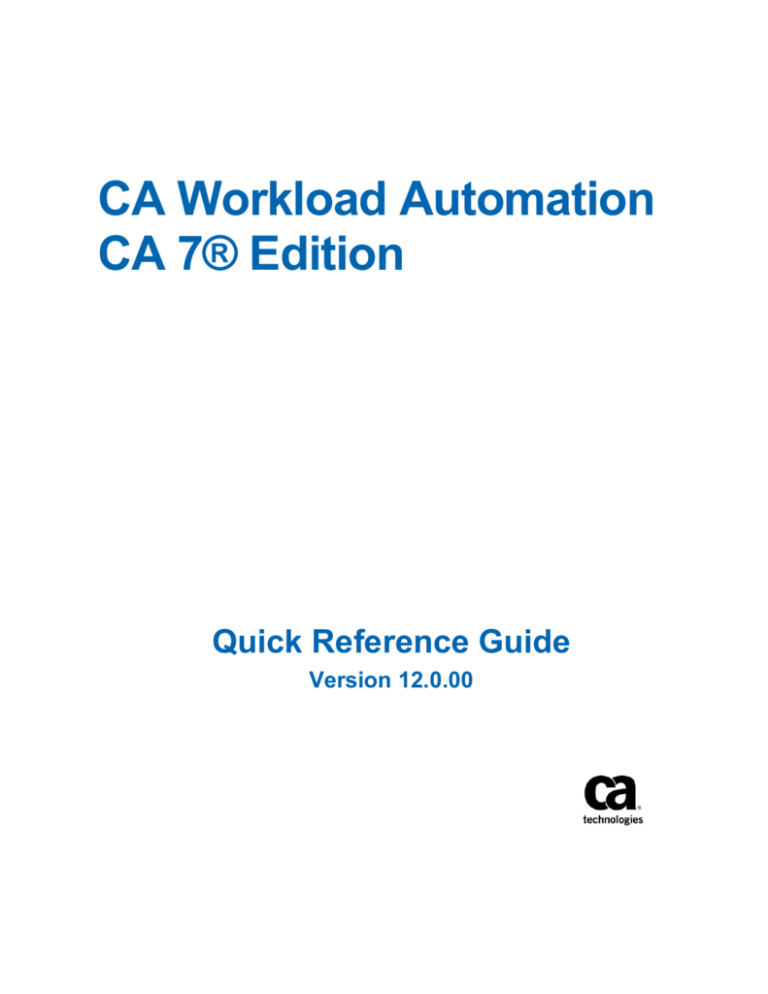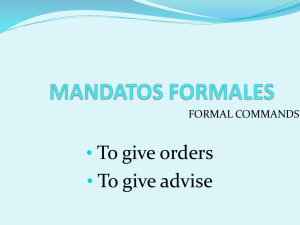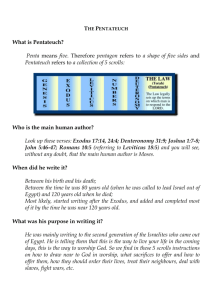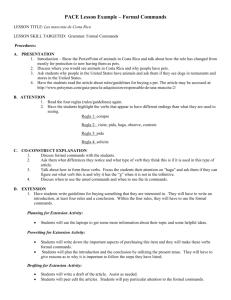
CA Workload Automation
CA 7® Edition
Quick Reference Guide
Version 12.0.00
This Documentation, which includes embedded help systems and electronically distributed materials (hereinafter referred to as
the “Documentation”), is for your informational purposes only and is subject to change or withdrawal by CA at any time. This
Documentation is proprietary information of CA and may not be copied, transferred, reproduced, disclosed, modified or
duplicated, in whole or in part, without the prior written consent of CA.
If you are a licensed user of the software product(s) addressed in the Documentation, you may print or otherwise make
available a reasonable number of copies of the Documentation for internal use by you and your employees in connection with
that software, provided that all CA copyright notices and legends are affixed to each reproduced copy.
The right to print or otherwise make available copies of the Documentation is limited to the period during which the applicable
license for such software remains in full force and effect. Should the license terminate for any reason, it is your responsibility to
certify in writing to CA that all copies and partial copies of the Documentation have been returned to CA or destroyed.
TO THE EXTENT PERMITTED BY APPLICABLE LAW, CA PROVIDES THIS DOCUMENTATION “AS IS” WITHOUT WARRANTY OF ANY
KIND, INCLUDING WITHOUT LIMITATION, ANY IMPLIED WARRANTIES OF MERCHANTABILITY, FITNESS FOR A PARTICULAR
PURPOSE, OR NONINFRINGEMENT. IN NO EVENT WILL CA BE LIABLE TO YOU OR ANY THIRD PARTY FOR ANY LOSS OR DAMAGE,
DIRECT OR INDIRECT, FROM THE USE OF THIS DOCUMENTATION, INCLUDING WITHOUT LIMITATION, LOST PROFITS, LOST
INVESTMENT, BUSINESS INTERRUPTION, GOODWILL, OR LOST DATA, EVEN IF CA IS EXPRESSLY ADVISED IN ADVANCE OF THE
POSSIBILITY OF SUCH LOSS OR DAMAGE.
The use of any software product referenced in the Documentation is governed by the applicable license agreement and such
license agreement is not modified in any way by the terms of this notice.
The manufacturer of this Documentation is CA.
Provided with “Restricted Rights.” Use, duplication or disclosure by the United States Government is subject to the restrictions
set forth in FAR Sections 12.212, 52.227-14, and 52.227-19(c)(1) - (2) and DFARS Section 252.227-7014(b)(3), as applicable, or
their successors.
Copyright © 2013 CA. All rights reserved. All trademarks, trade names, service marks, and logos referenced herein belong to
their respective companies.
CA Technologies Product References
This document references the following CA Technologies products:
■
CA Workload Automation CA 7® Edition, (CA WA CA 7 Edition), formerly CA
Workload Automation SE and CA 7® Workload Automation
Contact CA Technologies
Contact CA Support
For your convenience, CA Technologies provides one site where you can access the
information that you need for your Home Office, Small Business, and Enterprise CA
Technologies products. At http://ca.com/support, you can access the following
resources:
■
Online and telephone contact information for technical assistance and customer
services
■
Information about user communities and forums
■
Product and documentation downloads
■
CA Support policies and guidelines
■
Other helpful resources appropriate for your product
Providing Feedback About Product Documentation
If you have comments or questions about CA Technologies product documentation, you
can send a message to techpubs@ca.com.
To provide feedback about CA Technologies product documentation, complete our
short customer survey which is available on the CA Support website at
http://ca.com/docs.
Contents
Chapter 1: Introduction
7
Chapter 2: Commands
9
Inquiry Commands ..................................................................................................................................................... 10
System Commands ..................................................................................................................................................... 17
Work Flow Control Commands .................................................................................................................................. 22
Work Flow Display Commands ................................................................................................................................... 27
Schedule Scan Command ........................................................................................................................................... 29
Resolve Command ...................................................................................................................................................... 29
Text Editor Commands ............................................................................................................................................... 30
Alternate Edit Mode ............................................................................................................................................ 30
Full Edit Mode ..................................................................................................................................................... 31
Forecasting Commands .............................................................................................................................................. 33
Workload Balancing Commands ................................................................................................................................ 35
Workload Planning Commands .................................................................................................................................. 36
Automated Performance Analysis Commands ........................................................................................................... 37
Utility Commands ....................................................................................................................................................... 38
Chapter 3: Scheduled Override Statements
41
Chapter 4: Panels
43
Automated Recovery Facility Panels .......................................................................................................................... 43
Database Maintenance Panels and Functions ........................................................................................................... 44
Queue Maintenance Panels ....................................................................................................................................... 47
Virtual Resource Management Panels ....................................................................................................................... 49
Utility Panels .............................................................................................................................................................. 50
Chapter 5: Reports
53
History Reports........................................................................................................................................................... 53
Workload Planning Reports........................................................................................................................................ 55
CA Earl and CA Easytrieve Reports ............................................................................................................................. 55
Reports Available from Log History Data ............................................................................................................ 56
Reports Available From Database .............................................................................................................................. 58
Contents 5
Chapter 1: Introduction
This guide summarizes commands, panels, and reports for CA Workload Automation CA
7® Edition (CA WA CA 7 Edition). The guide is intended as a quick reference guide for
production and operations users who are familiar with CA WA CA 7 Edition. For more
information about CA WA CA 7 Edition functions, see the following guides:
■
Command Reference Guide
■
Database Maintenance Guide
■
Primer
■
Report Reference Guide
Note: For information about reading syntax diagrams, see the Command Reference
Guide.
Chapter 1: Introduction 7
Chapter 2: Commands
This section contains the following topics:
Inquiry Commands (see page 10)
System Commands (see page 17)
Work Flow Control Commands (see page 22)
Work Flow Display Commands (see page 27)
Schedule Scan Command (see page 29)
Resolve Command (see page 29)
Text Editor Commands (see page 30)
Forecasting Commands (see page 33)
Workload Balancing Commands (see page 35)
Workload Planning Commands (see page 36)
Automated Performance Analysis Commands (see page 37)
Utility Commands (see page 38)
Chapter 2: Commands 9
Inquiry Commands
Inquiry Commands
These commands provide information about the system, its components, and its
operation, including database contents, catalog entries, queue information, job status,
and schedule information.
Note: For more information, see the Command Reference Guide.
FLOWL
FLOW, LIST
HELP
No keywords
LACT
AGENT, CLS, CPUID, DRCLASS, DRMODE, JOB, JOBL, LIST, NODE, SCHID, SEG, SEQ,
ST, SYS
LACTR
AGENT, CLS, CPUID, JOB, JOBL, LIST, MAINID, NODE, SCHID, SEQ, ST, SYS
LAGENT
AGENT, LIST
LARF
ARFSET, LIST
LARFQ
JOB
LCTLG
DSN, TZ, VOLSER
LDSN
DSN, DSNBR, LIST, USERS
LDTM
AGENT, CLS, JOB, JOBL, LIST, NODE, OUTAGE, ST, SYS
LGVAR
JOB, LIST, NAME, SCHID, SYS
LIST
JOB, JOBL, PROSE
LJCK
DATE, JOB, JOBL, JCLLIB, LIST, MEM, SCHID, TIME
10 Quick Reference Guide
Inquiry Commands
LJCL
JOB, JOBL
LJES
AGENT, CLS, CPUID, JOB, LIST, NODE, Q, ST, SYS
LJOB
ADATE, AGENT, ARFSET, ATIME, BDATE, BTIME, CLS, COND, CPU, CPUTIME, DDS,
DRCLASS, DSNLEAD, DSNMSG, ELT, EXEC, HOLD, JCLID, JCLLIB, JCLOVRD, JOB, JOBL,
JOBLEAD, JOBNET, LATES, LIST, LMNTDATE, LMNTTIME, LMNTTYPE, LRUNDATE,
LRUNTIME, LTERM, MAINID, MAINT, MEMBER, MSGCLASS, NODE, NXTCYC,
OVRDLIB, OWNER, PARMLIB, PROMPTS, PROSE, PRTY, REGION, RELOAD, RESTARTS,
RETAIN, RMS, RO, RQLIST, RQMTMSG, RUNS, SCHEDULE, STEPREST, STEPS, SYS,
TP1, TP1C, TP1M, TP2, TP2C, TP2M, TZ, USERID, VERIFY
LJOBR
See LJOB for keywords. LJOBR has no LIST option.
LLIB
DSN, LIST, MEM
LLOCK
DSN, JOB, LIST, SYS
LNODE
LIST, NODE, SEQ, STATE
LNTWK
DSN, LIST, NW
LPDS
DSN, MEM, VOLSER
LPOST
JOB, LIST, NW, SEG, SEQ, ST, STN, SUBID
LPRE
JOB, LIST, NW, SEG, SEQ, ST, STN, SUBID
LPROS
DD, DSN, DSNBR, JOB, LIST, NW, SEG, STEP, SYS, UID
LPRRN
CLS, CPUID, JOB, JOBL, LIST, SEG, SEQ, ST, SYS, TZ
LQ/LQUE
AGENT, CLS, CPUID, DRCLASS, DRMODE, JOB, JOBL, LIST, NODE, SCHID, SEG, SEQ,
ST, SYS, TZ
Chapter 2: Commands 11
Inquiry Commands
LQP
AGENT, CLS, CPUID, JOB, JOBL, LIST, NODE, SCHID, SEQ, ST, SYS
LQR
AGENT, CLS, CPUID, JOB, JOBL, LIST, MAINID, NODE, SCHID, SEQ, ST, SYS
LRDY
AGENT, CLS, CPUID, DRCLASS, DRMODE, JOB, JOBL, LIST, NODE, SCHID, SEG, SEQ,
ST, SYS
LRDYP
AGENT, CLS, CPUID, JOB, JOBL, LIST, NODE, SCHID, SEQ, ST, SYS
LRDYR
AGENT, CLS, CPUID, JOB, JOBL, LIST, MAINID, NODE, SCHID, SEQ, ST, SYS
LREQ
AGENT, CLS, CPUID, DRCLASS, DRMODE, JOB, JOBL, LIST, NODE, SCHID, SEG, SEQ,
ST, SYS
LREQP
AGENT, CLS, CPUID, JOB, JOBL, LIST, NODE, SCHID, SEQ, ST, SYS
LREQR
AGENT, CLS, CPUID, JOB, JOBL, LIST, MAINID, NODE, SCHID, SEQ, ST, SYS
LRES
JOB, Q, SYS
LRLOG
DATE, JOB, LIST, NW, OPT, SCHID, SEQ, SPAN, ST, SUBID, SYS, TZ
LRMD
JOB, SEQ, ST, STN
LSCHD
JOB, JOBL, LIST, NW, SCAL, ST, SYS
LSYS
JOB, JOBL, LIST, SYS
LWLB
LIST, MOD
12 Quick Reference Guide
Inquiry Commands
LXCF
LIST
PRINT
SCAL, YEAR
PRRNJCL
UPDATE
PRRNDEL
DAYS, JOB, UPDATE
The following syntax diagram summarizes keyword values for these commands.
[,ADATE={yyddd|(yyddd,yyddd)}]
[,AGENT={*|agent|mask}]
[,ARFSET={*|arfset|mask}]
[,ATIME={hhmm|(hhmm,hhmm)}]
[,BDATE={yyddd|(yyddd,yyddd)}]
[,BTIME={hhmm|(hhmm,hhmm)}]
[,CLS=x]
[,COND={nnnn|(nnnn,nnnn)}]
[,CPU={nn|(nn,nn)}]
[,CPUID={*|AGJ|mask|smfid|7XPJ}]
[,CPUTIME={mmss|(mmss,mmss)}]
[,DATE={*|yyddd|*yyddd|yyddd)}]
[,DAYS=nnn]
[,DD=ddname]
[,DDS={nnn|(nnn,nnn)}]
[,DRCLASS={*|@ANY|@NONE|drclass|mask}]
[,DRMODE={*|YES|NO}]
Chapter 2: Commands 13
Inquiry Commands
[,DSN={AUTO}]
{AUTO.DSnnnnnn}
{AUTO.Dnnnnnnn}
{dsname}
{JDEP.}
{JDEP.jobname}
{NW.}
{NW.network}
{NW.station.network}
{PP.}
{PP.dsname}
{PP.jobname.JOB}
{PP.job.step.dd}
{PP.network.NW}
{PP.system.SYS}
{PP.userid}
{PRED.}
{PRED.jobname}
{TRGD.}
{TRGD.jobname}
[,DSNBR={DS*}]
{DS0nnnnnn*}
{DSnnnnnnnn}
{PP*}
{PP00nnnnn*}
{PPnnnnnn}
[,DSNLEAD={nn|(nn,nn)}]
[,DSNMSG={N|Y}]
[,ELT={hhmm|(hhmm,hhmm)}]
[,EXEC={N|Y}]
[,FLOW={*|flowname|flowname*)}]
[,HOLD={N|Y}]
[,JCLID=nnnn]
[,JCLLIB={nnn|&xx...x}]
[,JCLOVRD={N|Y}]
[,{JOB={*|jobname|jobnumber|mask|NO}|JOBL={*|longjobname|mask}}]
[,JOBLEAD={nn|(nn,nn)}]
[,JOBNET={*|name|mask}]
[,LATES={nnn|(nnn,nnn)}]
[,LIST={ACCUM|AGJOB|ALL|AVL|BYSID|CALS|CPU|DEP|DEFS|
DEPJ|DSN|ERRORS|EXTL|FLOW|INTL|INW|JCL|JOB|JOBL|
JOBS|MERGE|N|NODD|NODEFS|NOLINK|NORM|NOUSER|NW|
NXTCYC|ONLY|ONW|PERM|PRM|PROS|Q|RQDSN|RQEXCP|
RQJOB|RQMT|RQNWK|RQUSR|RQVRM|SCHD|SHORT|
SIDnnn|SMF|STATS|STATUS|STEPDD|STN|TRIG|USE|
USERS|XJOB|XPJOB}
14 Quick Reference Guide
Inquiry Commands
[,LMNTDATE={yyddd|(yyddd,yyddd)}]
[,LMNTTIME={hhmm|(hhmm,hhmm)}]
[,LMNTTYPE={ANLZ|DBM|LOAD|SMF}]
[,LRUNDATE={yyddd|(yyddd,yyddd)}]
[,LRUNTIME={hhmm|(hhmm,hhmm)}]
[,LTERM=name]
[,MAINID={ALL|AGJ|agent jobtype|SYn|/SYn|-SYn|XPJ}]
[,MAINT={N|Y}]
[,MEM=member]
[,MEMBER={*|member|member*|mask}]
[,MOD=UCC7Rxxx]
[,MSGCLASS=x]
[,NAME={*|variable}]
[,NODE={nodename|mask}]
[,NW={*|networkname|mask}]
[,NXTCYC={OFF|SKIP}]
[,OPT={0|1}
[,OUTAGE={duration}
{(startdate,starttime,duration)}
{(startdate,starttime,end date,endtime)}]
[,OVRDLIB={N|Y}]
[,OWNER={*|owner|owner*|mask}]
[,PARMLIB={nnn|&xx...x}]
[,PROMPTS={N|Y}]
[,PROSE={NO|YES}]
[,PRTY={nnn|(nnn,nnn)}]
[,Q={*|ALL|ACT|PRN|RDY|RDYACT|REQ|REQACT|REQRDY}]
[,REGION={nnnn|(nnnn,nnnn)}]
[,RELOAD={N|Y|X}]
[,RESTARTS={nnn|(nnn,nnn)}]
[,RETAIN={N|Y}]
[,RMS={N|Y}]
[,RO={EQ|LT|GT|GE|LE|NE|#S|IG|0}]
[,RQLIST={N|Y}]
[,RQMTMSG={N|Y}]
[,RUNS={nnnn|(nnnn,nnnn)}]
[,SCAL=xx]
[,SCHEDULE={N|Y}]
[,SCHID={000|nnn}]
[,SEG={segment|(segment,subsegment)}]
[,SEQ={AGENT|ALT1|ALT2|CA7|DATE|DLTM|DOTM|JOB|NATV|NODE|NW|PRTY|REV|STATE|SUBID}]
Chapter 2: Commands 15
Inquiry Commands
[,SPAN={current date}
{date}
{scope}
{(start date,start time,scope)}
{(start date,start time,end date,end time)}]
[,ST={*|ABND|AGENT|ARAE}|ARF|ARFH|ARFJ|CANC|CANCEL|CBAD|COMP|EXCP|EXP|FORCE|
HELD|JAN|JCLO|JCLR|JUL|LATE|MANV|MJOB|MOD|NODE|NOID|NRV|REPEAT|REPLY|
REPT|REQU|RPET|RSTR|RTRY|SKEL|SUBM|WRSC}]
[,STATE={FAIL|OFF|OFFLINE|ON|ONLINE|STOP}]
[,STEP=stepname]
[,STEPREST={N|Y}]
[,STEPS={nnn|(nnn,nnn)}]
[,STN={*|stationname|mask}]
[,SUBID={*|subid|subid*|mask}]
[,SYS={*|systemname|mask}]
[,TIME=hhmm]
[,TP1={nnn|(nnn,nnn)}]
[,TP1C={nnn|(nnn,nnn)}]
[,TP1M={nnn|(nnn,nnn)}]
[,TP2={nnn|(nnn,nnn)}]
[,TP2C={nnn|(nnn,nnn)}]
[,TP2M={nnn|(nnn,nnn)}]
[,TZ={CA7|EXEC}]
[,UID=xxx...x]
[,UPDATE={NO|YES}]
[,USERS={0,32767|minimum,maximum}]
[,USERID=nnn]
[,VERIFY={N|Y}]
[,VOLSER=xxxxxx]
[,YEAR=yy]
16 Quick Reference Guide
System Commands
System Commands
These commands let the CA WA CA 7 Edition terminal operator perform various
functions.
Note: For more information, see the Command Reference Guide.
/AFM
No keywords
/AGENT
AGENT, FUNC, PERSIST, PROP
/ASSIGN
BARR, CPU, LTERM, MAINID, TERM
/AUTO
COUNT, INT, MSG
/BRO
MSG, TERM
/CHANGE
APPL, OPERID, PRTY, TERM
/CHGOPT
LIST,option
/CLOSE
GROUP, TERM
/COID
ID
/CONT
MSG
/COPY
LTERM
/DELAGNT
AGENTDAY, UPDATE
/DISPLAY
APPL, CPU, DB, FMTBLK, LINE, LTERM, PERF, POOLS, PRINT, Q, STATUS, TERM
/DRCLASS
ACT, CLASS
Chapter 2: Commands 17
System Commands
/DRMODE
DEFCLASS, MODE, RQMTS, TRIGGERS
/EADMIN
EFROM, ENABLE, EREPLY, ETIMEOUT, TRC
/ECHO
MSG
/EMAIL
JOB, TO, TRC, TXT, VAR
/FETCH
No keywords
/GVAR
JOB, NAME, OPT, SCHID, SYS, VALUE
/IAS
FUNC, LOGDD, LOGTYPE
/JCL
ALT, DPROC, DSN, INDEX, LTERM, OPT
/LOG
DATA
/LOGOFF
TERM
/LOGON
NPW, password, PRM, UID, userid
/MSG
ID, LTERM, MSG
/NXTMSG
No keywords
/OPEN
GROUP, TERM
/OPERID
No keywords
/OPERIDS
ID
18 Quick Reference Guide
System Commands
/PAGE
No keywords
/PAnn
MSG
/PFnn
MSG
/PROF
EXRSLV, KEYS, R, ST
/PROFS
EXRSLV, ID, KEYS, R, ST
/PURGPG
LTERM
/REFRESH
MOD
/RELINK
APPL, FMTBLK, USERID
/RESET
No keywords
/SDESK
EVENT, JOB
/SHUTDOWN
Zn
/START
LINE, LTERM, MSG, TERM
/STATEMGR
ARM, OPSSSM
/STOP
LINE, LTERM, MSG, TERM
/SWAP
No keywords
/UID
R, LIST
Chapter 2: Commands 19
System Commands
/WLB
BARR, SET
/WTO
MSG
/XCF
INST, OPT, SMF
/XTASK
MSG
The following syntax diagram summarizes keyword values for these commands.
[,AGENTDAY=nn]
[,AGENT=agent]
[,ACT={ADD|DEL}]
[,ALT={nnn|xx...x|NO}]
[,{A|APPL}={ALL|xxxx|SASSx|SASSxx|SASSxxx|SASSxxxx}]
[,ARM={NO|YES}]
[,BARR={nnnn|+nnn|-nnn}]
,CLASS=(xx1,...,xx8)
[,COUNT=nnn]
[,CPU={ALL|UCC7IRDn|UCC7SUBn}]
[,{D|DATA}=xxx...x]
[,DB={DATACOM|LOG}]
[,DEFCLASS={@SYSTEM|value}]
[,DPROC={dsname|NO|*NONE*}]
[,DSN=dsname]
[,EFROM=xxx...x]
[,ENABLE={Y|N}]
[,EREPLY=xxx...x]
[,ETIMEOUT=nn]
,EVENT=xxxxx
[,EXRSLV={NO|YES}]
[,{FM|FMTBLK}={ALL|SCALyy|SCALyyz|SCALyyzz|SFMxyy|SFMxyyy|SFMxyyyy}]
[,FUNC={AGLOGOFF|AGLOGON|CLRFILES|LOGCLEAR|LOGPRINT|LOGRESET|LOGSET|
LOGSTART|LOGSTOP|PING|RECONFIG|REFRESH|SHUTDOWN|STARTCOM|STOPCOM}]
[,GROUP=xxxxxxx]
[,ID={ALL|userid|*ACT*|*|nnn}]
[,INDEX=&xxx...x]
[,INT={5|nnn}]
[,INST=xxxx]
[,JOB={*|jobname|jobnumber|mask}]
[,KEYS={CLEAR|PROF|PROFILE|SAVE}]
[,{L|LINE}={ALL|xxxxxxx|mask}]
20 Quick Reference Guide
System Commands
[,LOGDD=ddname]
[,LOGTYPE=nnn]
[,{LT|LTERM}={ALL|MASTER|xxxxxxxx}]
[,{M|MSG}={xxx...x}]
{PROMPTS}
{(functionname,taskname[,cmdtext])}
{mask}
[,{MA|MAINID}={SY*|SYn}]
[,MOD={MSGRCNTL|SERVDESK|xxxxxxxx}]
[,MODE={DR|NORM}]
,NAME=variable
[,NPW=xxxxxxxx]
[,{O|OPERID}=opid]
[,OPSSSM={NO|YES}]
[,OPT={ADD|DEL|MOD|UPD}]
[,PERF={ALL|JES|SCT|VRM|ZOS}
[,PERSIST={NO|YES}]
[,{POOLS|PL}={ALL|APG|DSN|G64|JOB|MSG|NSP|N31|RES}]
[,{PR|PRINT}={ALL|SCH}]
[,PRM=xxx...x]
[,PROP=name=value]
[,{P|PRTY}=nn]
[,Q={ALL|DQT|JCQ|MSQ|QHD|SCR|STQ}]
[,R={uid name|resource name}]
[,RQMTS={DR|ALL}]
[,SET={CLASSx|INITS|MINJOB|ON|OFF|T1TAV|T1MAX|T2TAV|T2MAX}]
[,SCHID={0|nnn|*}]
[,SMF=xxxx]
[,{ST|STATUS}={CA7|DELETE|DPROC|DR|EMAIL|HIJBNUM|HIJOB|
JCL|JCLVAR|KEY|SDESK|SEC|SECURITY|SUB|XPS}]
[,SYS={*|systemid|mask}]
[,{T|TERM}={*|**ALL**|?|ALL|TCP/IP|xxxxxxxx|mask}]
,TO=member
[,TRIGGERS={ALL|DR|NONEXEC}]
[,TRC={Y|N}]
,TXT=member
[,UPDATE={NO|YES}]
[,{U|USERID}=xx]
[,UID=resource]
[,{VAL|VALUE}=string]
[,VAR=(value1,...value8)]
Chapter 2: Commands 21
Work Flow Control Commands
Work Flow Control Commands
Use these commands to monitor and modify jobs under CA WA CA 7 Edition control.
Note: For more information, see the Command Reference Guide and Database
Maintenance Guide.
ADDRQ
DEPJOB, JOB, USR
ADDSCH
JOB, REF, TIME
AGFILE
JOB, LIST, NAME, NUMBER, OBJECT, OFFSET, STEPNUM, TYPE
ARFP
FORCE, JOB
CANCEL
FORCE, JOB, JOBL, KILL, NW, REASON, SUBID
DEMAND/DEMANDH
ARFSET, CC, CLASS, COUNT, DATE, DEPJOB, DOTM, EXEC, INTERVAL, JCLID, JCLLIB,
JOB, JOBL, LATE, LEADTM, MAINID, PRTY, RMS, RO, SCHID, SET, STOP, TIME, TYPE
DIRECT
JOB, MAINID
DMDNW
DESC, JOB, LEADTM, NW, SCHID, SUBID
FLOWD
DATE, FLOW, JOBCNT, TIME
HOLD
JOB, JOBL, Q
IN
FORCE, REF
IO
FORCE, REF
JCLOVRD
JOB, SET
22 Quick Reference Guide
Work Flow Control Commands
JOBSTART
JOB, MODE
LOAD/LOADH
CLASS, DOTM, JCLID, JCLLIB, JOB, LATE, LEADTM, MAINID, SCHID, TIME
LOGIN
FORCE, INITS, JOB, NW, STATION, SUBID
LOGOUT
FORCE, INITS, JOB, NW, STATION, SUBID
NOPRMP
JOB, REF
NXTCYC
JOB, SET
OUT
No keywords
REF
No keywords
POST
DEPJOB, DSN, INTERNAL, JOB, JOBL, NW, PREQ, USR
PRMP
JOB, REF
PRSCF
FORCE, JOB, RSRC
PRSQA
RSRC, INTERNAL
PRSQD
RSRC, INTERNAL
QJCL
No keywords
QM
No keywords
RELEASE
JOB, JOBL, Q
Chapter 2: Commands 23
Work Flow Control Commands
REMIND
DATE, STATION, SUBID, TIME
REPLY
JOB, MSG
REQUEUE
CPU, FORCE, JOB, JOBL, MAINID, NODE, Q, TYPE
RESTART
BYPGDG, CONDCD, FORCECOMP, JOB, JOBL, LCC, LPSTP, LSTP, PROCEND, PROCESS,
PROCSTRT, REASON, STPEND, STPSTRT, SUP11STP, USAGE
RSVP
JOB, NW, REF, STATION, SUBID
RUN/RUNH
ARFSET, CLASS, DOTM, EXEC, JCLID, JCLLIB, JOB, JOBL, LATE, LEADTM, MAINID, RMS,
SCHID, TIME, TYPE
RUNNW
DESC, JOB, LEADTM, NW, SCHID, SUBID
RUSH
JOB, REF
START
Q
STOP
Q
SUBMIT
EXPRESS, JOB
SUBSCH
JOB, REF, TIME
SUBTM
JOB, TIME
VERIFY
JOB, SET
24 Quick Reference Guide
Work Flow Control Commands
The following syntax diagram summarizes keyword values for these commands.
[,ARFSET={**NONE**|arfsetname}]
[,BYPGDG={CAT|NO|VER|YES}]
[,CC=nnnn]
[,CLASS=x]
[,CONDCD=nnnn]
[,COUNT=nnnn]
[,CPU=smfid]
[,DATE={+nn|yyddd}]
[,DEPJOB=jobname2]
[,DESC=xxxxxxxx]
[,DOTM={current time|hhmm}]
[,DSN={dsname|nnnnnnnn}]
[,EXEC={NO|YES}]
[,EXPRESS=YES]
[,FLOW=flowname]
[,FORCE={CMP|YES}]
[,FORCECOMP={NO|YES}]
[,INITS=xxxxxxxx]
[,INTERNAL={NO|YES}]
[,INTERVAL=hhmm]
[,JCLID=nnn]
[,JCLLIB=&xxx...x]
[,{JOB={ALL|ALLP|nnnn|jobname|jobnumber|refnumber|mask}|
JOBL={*|longjobname|mask}}]
[,JOBCNT=0]
[,KILL={NO|YES}]
[,LATE={NO|YES}]
[,LCC=nnnn]
[,LEADTM={0100|hhmm}]
[,LIST={NO|ALL|HIS|Q}]
[,LPSTP=procname]
[,LSTP=stepname]
[,{M|MSG}=xxx...x]
[,MAINID={ALL|SYn|/SYn|-SYn}]
[,MODE={A|I}]
[,NAME=file name]
[,NODE={*|nodename|mask}]
[,NUMBER={1|file number}]
[,NW={ALL|networkname}]
[,OBJECT=object-name]
[,OFFSET={0|nnnnnnnn}]
[,PREQ={nnnn|( ─ n1,n2,...,n11 ─ )}]
[,PROCEND=procname]
[,PROCESS={P|F|N|O|R|S}]
Chapter 2: Commands 25
Work Flow Control Commands
[,PROCSTRT=procname]
[,PRTY=nnn]
[,Q={ACT|ALL|RDY|REQ}]
[,REASON=text]
[,RMS={NO|YES}]
[,REF={nnnnrrs|(nnnnrrs,...)}]
[,RO={EQ|LT|GT|GE|LE|NE|#S|IG|0}]
[,RSRC=resource name]
[,SCHID={001|nnn}]
[,SET={NDB|NTR|OFF|ON|SKP|
RUN,LRDATE=yyddd,LRTIME={hhmm|hhmmss|hhmmssth}[,FORCE={NO|YES}]}]
[,STATION=stationname]
[,STEPNUM=step number]
[,STOP=hhmm]
[,STPEND={stepname|stepnumber}]
[,STPSTRT={stepname|stepnumber|*CMT*|*RERUN*|*RESUBP*}]
[,SUBID={ALL|xxxxxxxx}]
[,SUP11STP={NO|YES}]
[,TIME={hhmm|+hhmm|mmmm}]
[,TYPE={CHLOG|CHPROC|CHSTART|CLOCK|DELETE|DELETEB|DELETE1|
DELETE2|DUMP|END|ERROR|FILELIST|INFO|JCL|JOBLIST|LOG|
OUTPUT|RES|SPOOL|SPOOLREF|START|TRACE}]
[,USAGE=code]
[,USR=xxx...x]
26 Quick Reference Guide
Work Flow Display Commands
Work Flow Display Commands
These commands display jobs that have been brought into the queues for processing
and let you change their status.
Note: For more information, see the Command Reference Guide.
XPOST/XSPOST
FILL, JOB, NW, STN, SUBID
XPRE/XSPRE
FILL, JOB, NW, STN, SUBID
XQ
FILL, JOB, JOBL, LIST, Q, SEQ, SYS
XQJ
FILL, JOB, JOBL, LIST, Q, SEQ, SYS
XQM
FILL, JOB, JOBL, LIST, Q, SEQ, SYS
XQN
FILL, JOB, JOBL, LIST, Q, SEQ, SYS
XRQ
JOB, JOBL, LIST
XRST
JOB
XUPD
JOB, JOBL
The following syntax diagram summarizes keyword values for these commands.
[,FILL={C|E|F|H|I|J|O|P|Q|R|S|U|V|X}]
[,{JOB={*|jobname|jobnumber|mask}|JOBL={*|longjobname|mask}}]
[,LIST={ALL|ANY|BINT|EXT|HLD|INT|JCLO|JOB|NWK|REST|SKEL|SUB|USR|VER}]
[,NW={*|networkname|networkname*}]
[,Q={REQ|ACT|RDY}]
[,SEQ={ENTRY|JOBNAME|NUMBER}]
[,STN={*|stationname|stationname*}]
[,SUBID={*|subid|subid*}]
[,SYS={*|systemname|mask}]
Chapter 2: Commands 27
Work Flow Display Commands
The following are descriptions of the FILL parameters.
C
Cancel
E
Edit JCL
F
Go to restart panel or forced station login
H
Hold
I
Normal login
J
JCL override
O
Logout
P
Respond to prompt
Q
Requeue
R
Release
S
Submit time off
U
Update
V
Verification
X
Requirement post
28 Quick Reference Guide
Schedule Scan Command
Schedule Scan Command
This command displays the options that control the way CA WA CA 7 Edition scans the
database looking for jobs and networks that are scheduled for processing. You can also
use this command to change those options.
Note: For more information, see the Command Reference Guide.
SSCAN
DATE, INCR, LEADTM, PEREND, PERSTART, QDWELL, REPRMPT, RETRY, SCAN, SPAN,
TIME, XPRETRY
The following syntax diagram summarizes keyword values for this command.
[,DATE=yyddd]
[,INCR=hh]
[,LEADTM={0|mmmm}]
[,PEREND=hhmm]
[,PERSTART=hhmm]
[,QDWELL=mm]
[,REPRMPT=mm]
[,RETRY=mm]
[,SCAN={ABR|ARF|COM|HLD|LNG|REL|REP|RET|SCH}]
[,SPAN=hh]
[,TIME=hhmm]
[,XPRETRY=mm]
Resolve Command
This command creates or changes schedules for jobs and networks that are processed
on a date/time basis.
Note: For more information, see the Command Reference Guide.
RESOLV
DUPDATE, JOB, NW, OLDYR, PRINT, SCAL, TEST, YEAR
The following syntax diagram summarizes keyword values for this command.
[,DUPDATE={YES|NO}]
[,JOB={*|jobname|jobname*}]
[,NETWORK={NW.|NW.network}
[,OLDYR={*|yy}]
[,PRINT={NO|YES}]
[,SCAL={*|xx}]
[,TEST={YES|NO}]
[,YEAR=yy]
Chapter 2: Commands 29
Text Editor Commands
Text Editor Commands
Use these commands to create and change JCL for queued JCL or to add free-form
documentation to the CA WA CA 7 Edition database.
Note: For more information, see the Database Maintenance Guide.
Alternate Edit Mode
The following commands are available in alternate edit mode.
BREAK [nn]
CLEAR
Copy i[,m,n,t]
Delete m[,n]
Edit
Edit LIST [m,n]
Edit /string/[m,n]
Edit /string1/string2/[m,n]
Edit /string1//[m,n]
Edit //string1/[m,n]
Edit x[,y]
EXIT
FEM [n]
INsert [m,i]
JCL
JCLL
JCLS
30 Quick Reference Guide
Text Editor Commands
JCLSR
JCLSS
List [m,n]
Move i[,m,n,i]
RENUM m,i
SAVE
SCALE [OFF]
SR
SS
STATUS
TRACE EDIT|OFF
XSEQ [OFF]
Full Edit Mode
The following commands are available in full edit mode.
BOTtom
BREAK [nn]
COL [n,m]
Copy i[,m,n,t]
EXIT
FILL
FIND /xxx...x/[n,m]
HB [n]
HF [n]
Insert [m,i]
Chapter 2: Commands 31
Text Editor Commands
JCL
JCLL
JCLS
JCLSR
JCLSS
JCLxx nnn,yyddd,hhmm
MD [n]
MIXED
Move i[,m,n,t]
NOFILL
NONUM
NUM
PB[n]
PF[n]
RENUM m,i
RETURN
SAVE
SR
SS
STATUS
TOP
TRACE EDIT|OFF
UPPER
XSEQ [OFF]
32 Quick Reference Guide
Forecasting Commands
Forecasting Commands
These commands forecast information. Use them for the following purposes:
■
Project the scheduled workload for a given time.
■
Display graphically the projected workload for successive short time intervals.
■
Report on tapes and JCL overrides ahead of their actual submission time.
Note: For more information, see the Command Reference Guide.
FALL
DRCLASS, DRMODE, FROM, JOB, JOBNET, LIST, LVL, MAINID, NW, RINT, SCHID, SEQ,
SPAN, STN, SYS, TO, TRIG, TYPE
FJOB
DRCLASS, DRMODE, FROM, JOB, JOBL, JOBNET, LIST, LVL, MAINID, NWOPT, RINT,
SCHID, SEG, SEQ, SPAN, SYS, TO, TRIG, TYPE
FPOST
FROM, NW, RINT, SEQ, SPAN, STN, TO
FPRE
FROM, NW, RINT, SEQ, SPAN, STN, TO
FQALL
DRCLASS, DRMODE, JOB, JOBNET, LIST, LVL, MAINID, NW, RINT, SEQ, SPAN, STN,
SYS, TO, TRIG, TYPE
FQJOB
DRCLASS, DRMODE, JOB, JOBL, JOBNET, LIST, LVL, MAINID, NWOPT, RINT, SEG, SEQ,
SPAN, SYS, TO, TRIG, TYPE
FQPOST
NW, RINT, SEQ, SPAN, STN, TO
FQPRE
NW, RINT, SEQ, SPAN, STN, TO
FQRES
DRCLASS, DRMODE, INT, JOB, JOBNET, LIST, LVL, NW, SPAN, STN, SYS, TO, TRIG
FQSTN
NW, RINT, SEQ, SPAN, STN, TO
FQTAPE
DRCLASS, DRMODE, JOB, JOBNET, SPAN, SYS, TO, TRIG
Chapter 2: Commands 33
Forecasting Commands
FRES
DRCLASS, DRMODE, FROM, INT, JOB, JOBNET, LVL, LIST, NW, SCHID, SPAN, STN, SYS,
TO, TRIG
FRJOB
DRCLASS, DRMODE, JOB, JOBL, JOBNET, LIST, LVL, SCHID, SYS, TYPE
FRQJOB
DRCLASS, DRMODE, JOB, JOBL, JOBNET, LIST, LVL, SCHID, SYS, TYPE
FSTN
FROM, NW, RINT, SEQ, SPAN, STN, TO
FSTRUC
DRCLASS, DRMODE, FROM, JOB, JOBL, JOBNET, LIST, LVL, SCHID, SYS, TRIG, TYPE
FTAPE
DRCLASS, DRMODE, FROM, JOB, JOBNET, SCHID, SPAN, SYS, TO, TRIG
The following syntax diagram summarizes keyword values for these commands.
[,DRCLASS=(class1,...,class8)]
[,DRMODE={YES|NO}]
[,FROM=(mmddyy,hhmm)]
[,INT=hhmm]
[,{JOB={*|jobname|(job1,job2,...,job10)|mask}|JOBL={*|longjobname|mask}}]
[,JOBNET={*|name|mask}]
[,LIST={ALL|CPU|GRPH|HDRS|#JOB|JOB|LAST|STN|TAPE|W|WP|WPS|WS}]
[,LVL={100|nnn}]
[,MAINID=SYn]
[,NW={*|networkname|mask}]
[,NWOPT={N|S}]
[,RINT=hhmm]
[,SCHID={0 or 1|nnn}]
[,SEG=(segment,subsegment)]
[,SEQ={DLDT|DODT|JOB|STN}]
[,SPAN={8|hhmm}]
[,STN={*|stationname|stationname*|(sta1,sta2,...,sta10)}]
[,SYS={*|systemname|mask}]
[,TO=(mmddyy,hhmm)]
[,TRIG={J|D|{DJ|JD}|N}]
[,TYPE={ACTUAL|ALL}]
34 Quick Reference Guide
Workload Balancing Commands
Workload Balancing Commands
Workload Balancing (WLB) analyzes jobs waiting for execution and sets priorities for
submittal by preset criteria, which include due-out times, CPU usage, tape drive usage,
user-assigned priorities, and external events.
Note: For more information, see the Command Reference Guide.
/WLB
BARR, SET
LWLB
MOD, LIST
RESCHNG
JOB, TP1, TP2
XWLB
No keywords
The following syntax diagram summarizes keyword values for these commands.
[,BARR=count/+count/-count]
[,JOB=jobname]
[,LIST={ALL|AVL|USE}]
[,MOD=modname]
[,SET={CLASSx|INITS|MINJOB|OFF|ON|T1TAV|T1MAX|T2TAV|T2MAX}]
[,TP1=nnn]
[,TP2=nnn]
Chapter 2: Commands 35
Workload Planning Commands
Workload Planning Commands
Workload planning (WLP) simulates and reports on what could have happened in the
data center as well as what should happen, given new processing objectives for the
existing workload.
Note: For more information, see the Command Reference Guide and Report Reference
Guide.
FWLP
DDNAME, DEMAND, DRCLASS, DRMODE, FROM, JOB, JOBNET, MAINID, RESA, RESP,
SCHID, SPAN, SYS, TO, TRIG, TYPE
The following syntax diagram summarizes keyword values for this command.
[,DDNAME={NONE|ddname}]
[,DEMAND={00|nn}]
[,DRCLASS=(class1,...,class8)]
[,DRMODE={YES|NO}]
[,FROM=mmddyy,hhmm]
[,JOB={*|jobname|(job1,job2,...,job10)|mask}]
[,JOBNET={*|name|mask}]
[,MAINID={ALL|SYn|/SYn}]
[,RESA={*|UCC7Rxxx}]
[,RESP={*|UCC7Rxxx}]
[,SCHID={0|nnn}]
[,SPAN={8|hh|hhhh}]
[,SYS={*|systemname|mask}]
[,TO=mmddyy,hhmm]
[,TRIG={J|N}]
[,TYPE={ACTUAL|ALL}]
36 Quick Reference Guide
Automated Performance Analysis Commands
Automated Performance Analysis Commands
Automated Performance Analysis (APA) is a reporting system that provides reports
online or in batch for any time period that is specified, from the current time back
through the previous two years.
Note: For more information, see the Command Reference Guide and Report Reference
Guide.
GRAPHD/GRAPHJ/GRAPHN/GRAPHS
DIV1, DIV2, FROM, GLINE, ID, LIST, SCALE, TO
The following syntax diagram summarizes keyword values for these commands.
[,DIV1=nnnnnnn]
[,DIV2=nnnnnnn]
[,FROM=mmddyy]
[,GLINE={CALC|PRIM|SCND}]
[,ID={nnnn|(nnnn,...)}]
[,LIST={ALL|DETL|HELP}]
[,SCALE=nnnnnnn]
[,TO=mmddyy]
Chapter 2: Commands 37
Utility Commands
Utility Commands
Use these commands to perform various utility functions, like cataloging data sets,
allocating volumes, and displaying DASD information.
Note: For more information, see the Command Reference Guide.
AL/ALC
DCB, DSN, SP, VOL
ALLOC
UNIT, VOL
BLDG
ENTRIES, FULL, INDX
CAT
CVOL, DSN, DVC, SEQ, UNIT, VOL
CONN
INDX, VOL
CTLG
DSN, DVC, ENTRY, SEQ, TYPE, VOL
DCONN
INDX
DEALLOC
VOL
DLTX
CVOL, INDX
DMPCAT
CVOL, DSN
DMPDSCB
DSN, VOL
DMPDSN
DSN, MEM, REC, VOL
FIND
DSN, VOL
LISTDIR
DSN, MEM, VOL
38 Quick Reference Guide
Utility Commands
LOC
DSN, VOLSER
MAP
DSN, LIST, VOL
RENAME
DSN, NEWNAME, VOL
SCRATCH/SCRATCHP
DSN, VOL
SPACE
VOL
UNC
CVOL, DSN
UT
No keywords
The following syntax diagram summarizes keyword values for these commands.
[,CVOL={SYSRES|xxxxxx|xxxxxxxx}]
[,DCB=(recfm,lrecl,blksize)]
[,DSN={*|dsname}]
[,DVC=nnnnnnnn]
[,ENTRIES=nnn]
[,ENTRY=n]
[,FULL={DELETE|EMPTY}]
[,INDX={xxxxxxxx|xxx...x}]
[,LIST={DSN|ALL}]
[,MEM=xxxxxxxx]
[,NEWNAME=new-dsname]
[,REC={1|nnnn}]
[,SEQ={n|nnn}]
[,SP=(type,prim,sec,dirblks)]
[,TYPE={ADD|CON|COPY|DEL|REPL}]
[,UNIT=xxxxxxxx]
[,VOL={ALL|SYSRES|xxxxxx|(vol1,vol2,...,vol5)|(vol1,vol2,...,vol10)}]
[,VOLSER=xxxxxx]
Chapter 2: Commands 39
Chapter 3: Scheduled Override
Statements
Use these statements to override JCL and other statements that are included in the JCL
for a job, thereby dynamically changing run stream contents to fit the needs of a
particular run.
Note: For more information, see the Database Maintenance Guide.
#ARF, SET=
Overrides the ARFSET designation on the job definition screen
#HLD
Hold job in the request queue
#JCL
Set a JCL override requirement
#JEND
End of #Jx override statements
#JI, BD=, BT=, ED=, ET=, ID=, JOB=, CV=, OA=, OB=
Include statements at queue entry time
#JO, BD=, BT=, ED=, ET=, ID=, JOB=, CV=, OA=, OB=
Omit statements at queue entry time
#MNT
Set run to maintenance type
#MSG,xxx...x
Send message to master station
#NOX
Make run nonexecutable
#NTR
Turn off triggering for this run
#RES, TP1=, TP2=, CPUTM=, ELAPTM=, PRT=, CLASS=,
Change resources
#SSC,COND=
Define step-level condition code tests
Chapter 3: Scheduled Override Statements 41
Utility Commands
#VER
Set verification requirement on
#XEND
End of #Xx override statements
#XI, BD=, BT=, ED=, ET=, ID=, CV=, OA=, OB=
Include statements at submission time
#XO, BD=, BT=, ED=, ET=, ID=, CV=, OA=, OB=
Omit statements at submission time
#7UNI
Flags JCL as a cross-platform submission job
The following syntax diagram summarizes keyword values for these commands.
[,BD={00000|yyddd}]
[,BT={0000|hhmm}]
[,CLASS=x]
[,COND=nnnn,ro,procstepname.stepname]
[,CPUTM=mmmss]
[,CV={DO|CU|DL}]
[,ED={99999|yyddd}]
[,ELAPTM=hhmm]
[,ET={2400|hhmm}]
[,ID={000|nnn|nnn-nnn|(nnn,...,nnn,...)}]
[,JOB=jobname]
[,OA={0000|hhmm}]
[,OB={2400|hhmm}]
[,PRT=nnn]
[,SET=nnnnnnnn]
[,TP1=nnn]
[,TP2=nnn]
42 Quick Reference Guide
Chapter 4: Panels
This section contains the following topics:
Automated Recovery Facility Panels (see page 43)
Database Maintenance Panels and Functions (see page 44)
Queue Maintenance Panels (see page 47)
Virtual Resource Management Panels (see page 49)
Utility Panels (see page 50)
Automated Recovery Facility Panels
Use the automated recovery facility panels to add, delete, or update sets of ARF
condition definitions.
Note: For more information, see the Database Maintenance Guide.
AR.3
ARF Condition Definition Maintenance
Chapter 4: Panels 43
Database Maintenance Panels and Functions
Database Maintenance Panels and Functions
Use the database maintenance panels for the following functions:
■
Define jobs, networks, data sets, and predecessors.
■
Schedule jobs and networks.
■
Add documentation to the database.
■
Maintain JCL.
■
Access and clear the text editor.
To display the Database Maintenance Menu, enter DB on any panel.
The corresponding top-line commands for the panels are in parentheses when
applicable.
Note: For more information, see the Database Maintenance Guide.
DB
Database Maintenance Menu
DB.1 (JOB)
CPU Job Definition
DB.10 (XPJOB)
XPJOB Definition
DB.11 (AGJOB)
Agent Job Definition
DB.A
Cross-Platform Jobs Menu
DB.2 (SCHD)
Scheduling Menu
DB.2.1 (SCHD,JOB)
CPU Job Scheduling
DB.2.1-E
CPU Job Scheduling Parameter Edit
DB.2.2 (SCHD,INWK)
Input Network Scheduling
DB.2.2-E
Input Network Scheduling Parameter Edit
44 Quick Reference Guide
Database Maintenance Panels and Functions
DB.2.3 (SCHD,ONWK)
Output Network Scheduling
DB.2.3-E
Output Network Scheduling Parameter Edit
DB.2.4 (SCHD,JTRG)
Job Triggering
DB.2.4L (SCHD,JTRGL)
Job Triggering (Long Job Name)
DB.2.5 (SCHD,NTRG)
Input Network Triggering
DB.2.5L (SCHD,NTRGL)
Input Network Triggering (Long Job Name)
DB.2.6 (SCHD,DTRG)
Data Set Triggering
DB.2.6L (SCHD,DTRGL)
Data Set Triggering (Long Job Name)
DB.2.7 (SCHDMOD)
Modification to Resolved Schedule Dates
DB.2.8 (CALMOD)
Base Calendar Maintenance
DB.3 (JOBCONN)
Job Predecessor/Successor Menu
DB.3.1 (JOBCONN,DSN)
Data Set Predecessors
DB.3.2 (JOBCONN,JOB)
CPU Job Predecessors
DB.3.2L (JOBCONN,JOBL)
CPU Job Predecessors (Long Job Name)
DB.3.4 (JOBCONN,NWK)
Input/Output Network Tasks
DB.3.4L (JOBCONN,NWKL)
Input/Output Network Tasks (Long Job Name)
Chapter 4: Panels 45
Database Maintenance Panels and Functions
DB.3.6 (JOBCONN,USR)
User Memo-Form Predecessors
DB.3.6L (JOBCONN,USRL)
User Memo-Form Predecessors (Long Job Name)
DB.4 (PROSE)
Workload Documentation Menu
DB.4.1 (PROSE,JOB)
CPU Job Documentation
DB.4.2 (PROSE,NWK)
Input/Output Network Documentation
DB.4.3 (PROSE,USER)
User-Defined Item Documentation
DB.4.4 (PROSE,DSN)
Dataset Documentation
DB.4.5 (PROSE,DD)
DD Statement Documentation
DB.4.6 (PROSE,SYS)
Application System Documentation
DB.5 (NETWORK)
Input/Output Network Definition
DB.6 (DSN)
Data Set Definition
DB.7 (JCL)
JCL Library Maintenance
JRENAME,oldjob,NEWJOB=newjob(,QCHK=Y|N,UPDATE=Y|N,LIST=Y|N)
Rename a job and the elements where it is used.
XN.1 (XNODE)
XPJOB Node Definition
XN.2 (XPSWD)
XPJOB User-ID/Password Definition
XN.3 (AGPSWD)
Agent User-ID/Password Definition
46 Quick Reference Guide
Queue Maintenance Panels
Queue Maintenance Panels
Use the queue maintenance panels to display status, change JCL, and control jobs and
networks that have been brought into the CA WA CA 7 Edition queues for processing. To
display the Queue Maintenance Menu, enter QM on any CA WA CA 7 Edition panel.
Note: For more information, see the Command Reference Guide.
QM
Queue Maintenance Menu
QM.1
Jobs Status Prompt
QM.1-X
Jobs Status
QM.1-XC
Reason for Cancel
QM.1-M
Jobs Status (RQMTS)
QM.2
Job Predecessors Prompt
QM.2-X
Job Predecessors
QM.3
Job Attributes Prompt
QM.3-X
Job Attributes
QM.4
Job in Restart Status Prompt
QM.4-X
Job in Restart Status
QM.5
Queued JCL
QM.6
Input Networks Prompt
Chapter 4: Panels 47
Queue Maintenance Panels
QM.6-X
Input Networks (1-Up Display)
QM.6-S
Input Networks (2-Up Display)
QM.7
Output Networks Prompt
QM.7-X
Output Networks (1-Up Display)
QM.7-S
Output Networks (2-Up Display)
QM.8.1
List of Agent Job Executions
QM.8.2
Agent Job Display Information for Requested Function
48 Quick Reference Guide
Virtual Resource Management Panels
Virtual Resource Management Panels
Use the Virtual Resource Management (VRM) panels to define job resource
dependencies, list jobs using VRM resources, display pending resources and add,
update, or delete a resource type count resource. To display the Virtual Resource
Management Menu, enter RM on any CA WA CA 7 Edition panel.
Note: For more information, see the Database Maintenance Guide.
RM
Virtual Resource Management Menu
RM.1
Job Resource Management
RM.2
Job/Resource Cross Reference List
RM.3
Active Job Resources Display
RM.4
Pending Resources Job Display
RM.5
Jobs Waiting on Resources
RM.6
Corequisite Resources List
RM.7
Resource Count Resource Management
Chapter 4: Panels 49
Utility Panels
Utility Panels
Use the utilities panels to perform various utility functions. These include cataloging
data sets, allocating volumes, and displaying DASD information. To display the Utilities
Menu, enter UT on any CA WA CA 7 Edition panel.
Note: For more information, see the Command Reference Guide.
UT
Utilities Menu
UT.1
Allocate Dataset
UT.2
Catalog Dataset
UT.3
Rename Dataset
UT.4
Scratch Dataset
UT.5
Uncatalog Dataset
UT.6
Build GDG Index
UT.7
Delete Index
UT.8
Connect a Catalog
UT.9
Disconnect a Catalog
UT.10
Find DSN on DASD
UT.11
Allocate Volume
UT.12
Deallocate Volume
50 Quick Reference Guide
Utility Panels
UT.13
Display Format 1 DSCB
UT.14
Display Directory Info
UT.15
Display Dataset Attributes Map
UT.16
Display Available DASD Space
UT.17
Display Physical Data Records
UT.18
Display Catalog Block
UT.19
Display Catalog Entries
Chapter 4: Panels 51
Chapter 5: Reports
This section contains the following topics:
History Reports (see page 53)
Workload Planning Reports (see page 55)
CA Earl and CA Easytrieve Reports (see page 55)
Reports Available From Database (see page 58)
History Reports
CA WA CA 7 Edition creates log data set records that are used by the history reporting
facility to create reports on system activity.
Note: For more information, see the Report Reference Guide.
01
Scheduled Jobs Not Run
02
Transaction Detail
03
Log Dump
04
Scheduled vs. Actual Job
05
Scheduled vs. Actual Station
06
Job Processing Activity
07
Workstation Activity
08
Master Station Activity (Browse data set)
09
Cross Platform Activity
10
Cross Platform Job Completion Profile
Chapter 5: Reports 53
History Reports
11
Internal Cross Platform Submission Activity
12
Database Update Transaction Detail
13
Abnormal Job Termination
16
VRM Evaluation and Posting Activity
20
Submit Cycle Summary
21
Submit Job Detail
22
Job Non-Submission Analysis
23
Job Submission Activity
24
Job Submission Output Activity
25
Metrics Report and Metrics Comparison Report
30
Security Exceptions
50
Last Logged Status of Jobs
Generated Batch Terminal Interface Commands
Simulated LQ Display of Jobs
Recovery Aid Batch Commands
51
Request Queue Recovery Aid Commands
Generated BTI Commands
70
Internal Activity Trace
54 Quick Reference Guide
Workload Planning Reports
Workload Planning Reports
The workload planning facility generates reports that provide resource usage and job
run information, based on simulated runs.
Note: For more information, see the Report Reference Guide.
WLP01
Card Input Edit
WLP02
Hourly INIT Usage Projection
WLP03
Hourly TP1 Usage Projection
WLP04
Hourly TP2 Usage Projection
WLP05
Hourly CPU Usage Projection
WLP06
Resource Summary Projection
WLP07
Job Summary - Projection
Job Summary - Actual
Detailed Resource Utilization - Projection
Detailed Resource Utilization - Actual
CA Earl and CA Easytrieve Reports
The interfaces with CA Earl and CA Easytrieve provide several predefined reports. The
reports are produced by defining the data you want and the date/time range for the
report and selecting the appropriate predefined CA Earl or CA Easytrieve definition.
These definitions are selected by using a "request ID." A batch job then produces the
requested reports.
Note: For more information, see the Report Reference Guide.
Chapter 5: Reports 55
CA Earl and CA Easytrieve Reports
Reports Available from Log History Data
The following reports are available from log history data.
Note: xx is ER for CA Earl and EZ for CA Easytrieve.
Job Completion Profile (CA7xx001)
Log type = 161
Request Queue Activity Profile (CA7xx002)
Log type = 161
Ready Queue Activity Profile (CA7xx003)
Log type = 161
Active Queue Activity Profile (CA7xx004)
Log type = 161
Preprocessing Queue Activity Profile (CA7xx005)
Log type = 161
Postprocessing Queue Activity Profile (CA7xx006)
Log type = 161
Prior-Run Queue Activity Profile (CA7xx007)
Log type = 161
Database DSD/DSM Record Activity Profile (CA7xx008)
Log type = 161
Database JBD/JBM Record Activity Profile (CA7xx009)
Log type = 161
Database NWD/NWM Record Activity Profile (CA7xx010)
Log type = 161
Database PPD/PPM Record Activity Profile (CA7xx011)
Log type = 161
Database SID/SIM Record Activity Profile (CA7xx012)
Log type = 161
Database SJD/SJM Record Activity Profile (CA7xx013)
Log type = 161
Database SOD/SOM Record Activity Profile (CA7xx014)
Log type = 161
56 Quick Reference Guide
CA Earl and CA Easytrieve Reports
Database Type I Record Activity Profile (CA7xx015)
Log type = 161
Composite Database Activity Profile (CA7xx016)
Log type = 161
Composite Queue Activity Profile (CA7xx017)
Log type = 161
Queue Posting Activity (CA7xx018)
Log type = 117
Job Scheduling/Completion Activity (CA7xx019)
Log type = 161
Tape Data Set Activity (CA7xx020)
Log type = 161
DASD Data Set Activity (CA7xx021)
Log type = 161
Workstation Network Scheduling Activity (CA7xx022)
Log type = 161
Input Network Performance Profile (CA7xx023)
Log type = 161
Output Network Performance Profile (CA7xx024)
Log type = 161
Communications Data Set Activity (CA7xx025)
Log type = 161
Schedule Scan Activity (CA7xx026)
Log type = 161
Queue Allocation Usage Profile (CA7xx027)
Log type = 162
Job Termination Posting Dwell Time (CA7xx028)
Log type = 005
Job Completion Dwell Time (CA7xx029)
Log type = 105
Queue Entry Dwell Time (CA7xx030)
Log type = 105
Chapter 5: Reports 57
Reports Available From Database
Transaction Response Time Profile (CA7xx031)
Log type = 161
/LOG Command Detail (CA7xx032)
Log type = 129
Trailer Queue Activity Profile (CA7xx033)
Log type = 161
In-Storage Trailer Queue Profile (CA7xx034)
Log type = 162
Performance Statistics Information Job Report (CA7xx035)
Log type = 161
Performance Statistics Information System Report (CA7xx036)
Log type = 161
Job Completion Table Data (CA7xx037)
Log type = 162
JCL Data Set Access Time (CA7xx038)
Log type = 164
Reports Available From Database
Included are SQL samples for creating a standard set of reports from the database using
the CA Datacom/AD DBSQLPR utility.
Note: For more information, see the Report Reference Guide.
SQL sample members are provided to produce the following reports from the database.
You can use these samples as models for creating customized user-defined reports.
Program-Job Cross Reference
AL2SXRF1
DSN-Program Cross Reference
AL2SXRF2
Node-Job Cross Reference
AL2SXRF3
Datasets with No Associated Jobs
AL2SDSNJ
58 Quick Reference Guide
Reports Available From Database
Networks with No Associated Jobs
AL2SNWNJ
System Prose
AL2SSYPR
Job Prose
AL2SJBPR
Dataset Prose
AL2SDSPR
Network Prose
AL2SNWPR
User Prose
AL2SUSPR
DD Prose
AL2SDDPR
CPU Job Schedules with Current SCHDMOD
AL2SJSCH
Network Schedules with Current SCHDMOD
AL2SNSCH
Job-ARFSET Cross Reference
AL2SARFX
Chapter 5: Reports 59








